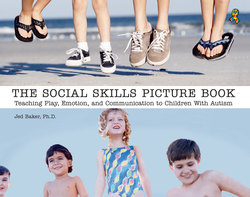Читать книгу The Social Skills Picture Book - Jed Baker PhD - Страница 14
На сайте Литреса книга снята с продажи.
Оглавлениеxiii
share, all come naturally when a person can easily take another’s perspective. However, these social skills do not come
naturally to autistic individuals, and must be taught explicitly.
The Social Skills Picture Book
attempts to do just that, to
break down social skills into their components and make explicit what to do and say in social situations.
The Importance of Visual Aids in Teaching Children with Autism Spectrum Disorders
People with autism often have language and attention issues that interfere with their ability to learn from verbal
explanations alone. As described earlier, many autistic individuals have difficulty comprehending language itself. For
those others who have little trouble comprehending words, they may, nevertheless, have great difficulty staying attentive
while learning tasks, especially if they become obsessively focused on their own area of interests. The benefits of using
visual aids to facilitate greater understanding and comprehension among autistic students have been well documented
(e.g., Quill, 1995). Most students, even those without disabilities, benefit from visual aids that back up a verbal
explanation. This is because visual pictures (a) can make abstract verbal concepts more concrete, (b) remain stable over
time, while auditory information can be missed as students’ attention fluctuates, and (c) provide a more powerful means
to engage attention.
The Social Skills Picture Book
uses a primarily visual strategy to teach social skills. Although the picture sets may
benefit “typical” students, they will be particularly helpful for youngsters with auditory/language processing difficulties,
difficulties in abstract thinking, and for those with difficulties sustaining attention. This includes children on the autism
spectrum, those with Attention Deficit/Hyperactivity Disorders, and individuals with learning disabilities.
